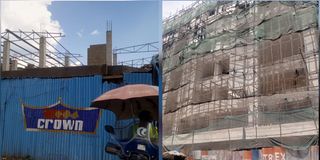Why new commercial buildings are rising in Nakuru as existing ones sit empty

(left) A commercial building coming up along Oginga Odinga and a building coming up along Mburu Gichua Road. Photo taken on September 18,2025.
Walking through Nakuru’s city centre, one cannot miss the sight of new buildings steadily rising.
From Kenyatta Avenue to Mburu Gichua Road and Oginga Odinga Street, constructions dominate the skyline.
Shoppers Paradise and CK Patel Plaza now have a new neighbor, with the construction currently at the third floor and earmarked as a commercial development.
Along Mburu Gichua Road, a once-stalled project near Supreme Pharmacy has resumed, and the six-storey building is taking shape.
Along Oginga Odinga Street, opposite Taidys Hotel, another commercial block is slowly climbing upward.
Additionally, the building opposite Jamaa adjacent to Eastmark was stalled for a very long time is almost operational. The once dilapidated iron sheets have since been removed exposing the dark brown aesthetic.
At first glance, this construction boom seems like a welcome sign of progress. More plazas suggest more choices for shoppers and office seekers.
Yet, beneath the optimism lies a growing contradiction. While buildings rise, many businesses within Nakuru are quietly closing their doors.
Business expert Evelyn Wanjiku notes that the city is caught in a paradox.
“On one hand, towering commercial buildings are steadily being constructed, signaling investor confidence in the city’s future. On the other, many once-thriving businesses are closing shop,” she says.
She says that rising food and utility costs, changing consumer tastes, and reduced disposable income have cut profits to the bare minimum. Even larger businesses, once considered stable, are now feeling the pinch of the economic slowdown.
Wanjiku notes that the decline of SMEs is being driven by several forces like inflation that has pushed up costs, and the changing dynamics in businesses like online delivery platforms have eaten into traditional clientele.
She notes that investors believe Nakuru’s city status and strategic location along the Nairobi–Eldoret corridor will fuel long-term demand.
This trend also exposes a deeper money flow imbalance. While developers often have access to large capital reserves and loans, SMEs depend on daily sales to survive.
She notes that policy and administration add to the puzzle with multiple licenses, taxes, and fees weigh heavily on businesses, while approvals for large-scale projects continue uninterrupted.
"Without deliberate support for small traders, the construction boom risks widening the gap between rising buildings and struggling businesses," she says.
Nakuru’s skyline tells two stories, one of growth in concrete and steel, and another of survival battles for businesses.


